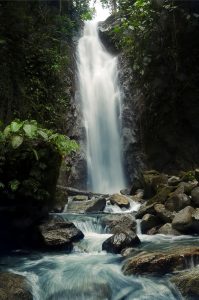Compostela Valley — or Comval for short — is the country’s 78th province. With a total land area of 4,666.93 square kilometers, it is often touted as “rough, rugged, and mostly undeveloped.” So much so that its tourism tagline is: “Conquering Compostela Valley.”
“A land of waterfalls, caves, lakes, rivers, towering mountain ranges and forests, gold and silver deposits, sulfuric hot and cold springs, and inland and beach resorts,” replied Christine T. Dompor, the provincial tourism officer, when asked to describe Comval.
As such, you can find in this province rare and endangered species like the Philippine eagle (the country’s national bird), the exotic Rafflesia mira (one of the world’s biggest single flower), Philippine deer, various kinds of snakes, and a host of still unidentified flora and fauna.
Not only that. Six of the major tribes in Mindanao are living in the province: Mandaya, Mansaka, Dibabawon, Ka’agan, Ata-Manobo, and Mangguangan. What is interesting is that each of them has their own myths, legends, arts and music, and age-old customs and traditions.
Here are the province’s points of interest:

Kopiat Island: This 95-hectare island of powdery white sands has unspoiled reef areas with rare beds serve as sanctuary for exotic tropical fish and endangered marine turtles, particularly hawksbill and leatherback.
Lunod Island: Lush mangrove forests cover almost the whole island’s 17-hectare area, which is located not far from Kopiat Island. “At night, the place turns into a magical wonder as the whole area is lighted with fireflies,” Dompor informed. Also known as Saint Anthony Island, it is a 15-minute banca ride from the coast of Beach View Resort.
Beach View Resort: This resort, in Pindasan, Mabini, has the widest vacant space for outdoor events among all beach resorts in the province. It also has the most modern cosmopolitan bar.
Welborn’s Beach Resort Hidden Paradise: Located in Baybay, Magnanga in Pantukan, it has a wide stretch of sand in the beach for children and adults to walk and play. The sea bed is flat and there are no stones or corals that make bare walking dangerous.
Mainit Sulfuric Hot Waterfall: A must-see in barangay Mainit in Mawab. If you have no seen a steaming fall in your life, then this is the area to visit. I tried to walk in the steaming water below the waterfall and indeed it was hot!

Lake Leonard: In the highland barangay of New Leyte in Maco, visitors can be mesmerized by this lake, a caldera of Mount Leonard Kniasseff, one of the 22 active volcanoes in the country whose last eruption was reported in the second century A.D. The 200-hectare lake was used before as a dumping ground for mining wastes until the mining company ceased operation in the early 90’s. Today, the lake is teemed with tilapia.
Aguakan Cold Spring Resort: Located in Maragusan, it has an Olympic-size swimming pool, whose water comes from nearby springs. The water is touted to be “as cold as ice.”
Kanlawig Hot Springs Resort: If cold is not your thing, then go to this resort which is not far from the Aguakan Cold Spring Resort. Here, you can enjoy swimming at the steaming hot water.
Haven’s Peak: Also in Maragusan, it is a resort nestled on Tarago Hills facing the town. It takes more than 200 steps just to reach the top. Once you’re there, you get to see the whole town and the forest that surround it.

Tagbibinta Falls: Maragusan is blessed with several waterfalls but this is the most famous among them. It has a series of seven falls, the first one measuring approximately 70 feet in height. “The falls was named as such because the place used to be the business center,” said Dennis B. Radin, the town’s tourism officer.
Bulawan Junction: A provincial landmark that reflects the province’s position as one of the biggest sources of gold and other valuable minerals in the Philippines. It is located in barangay Olaycon, about seven kilometers from the town of Monkayo.
Laak Caves: Unofficial information puts the number of caves at more than 100. Most of them can be found in barangay Sisimon and barangay Andap.
Mt. Tagub-Mt. Manurigao-Mt. Kandalanga Range: An unexplored pristine world of nature. The three peaks are sites of national, regional, and local annual mountain climbs and nature watching during the Holy Week and the month of October.
How to get there: Comval is accessible by air, land, and sea transportation. Davao City, 979 kilometers from Manila, is the gateway to the province. On arriving at the airport, take a taxi or a bus ride to Davao City Overland Transport Terminal at Ecoland to board a bus to Nabunturan, the capital town, 90 kilometers away and a two-hour ride. Once you’re there, you can transfer to any public utility vehicle for another ride to any destination in the province






